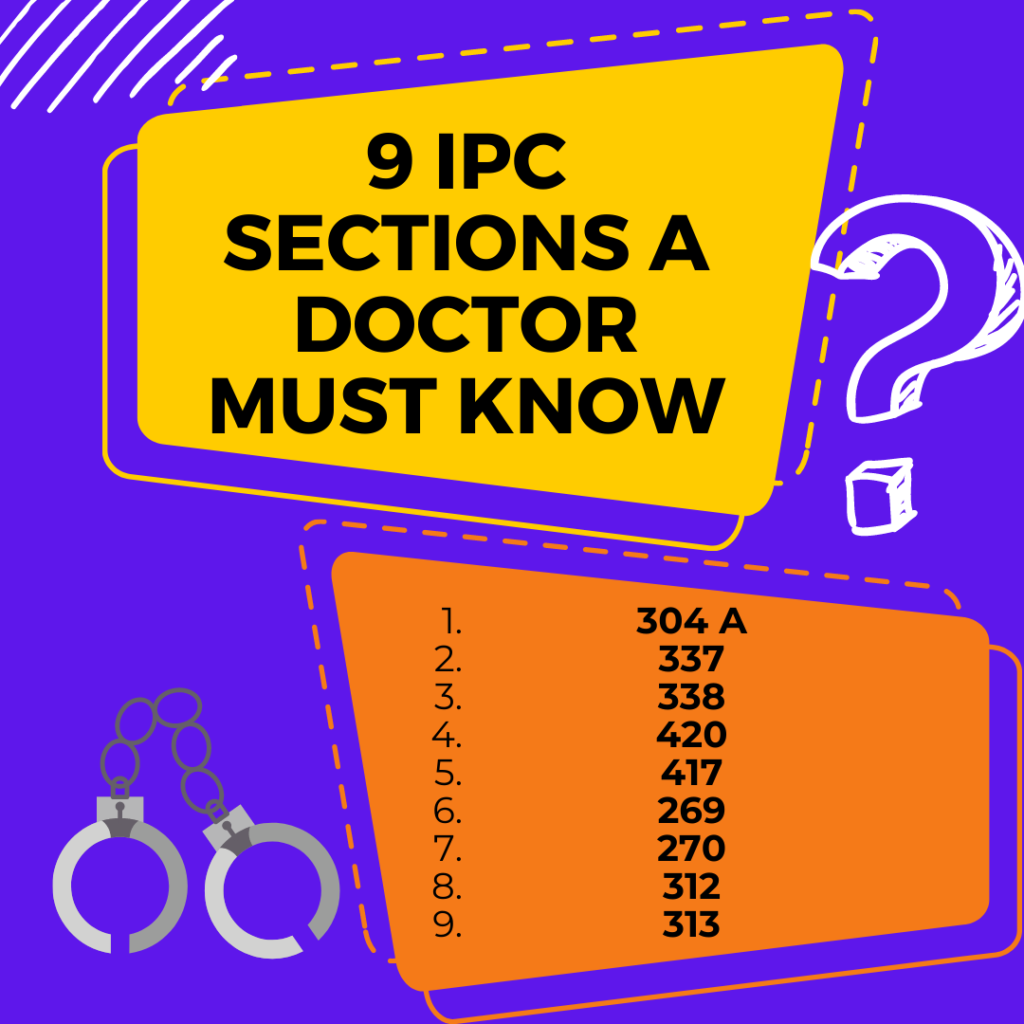IPC Sections A Doctor Must Know

9 IPC SECTIONS A DOCTOR MUST KNOW.
This is the list of 9 important indian penal code (IPC) sections a doctor must know. The doctors can be prosecuted if there is any violation by doctor with respect to dealing with the patients.
1.Section 304A – Causing death by negligence: This section deals with situations where a person causes the death of another person due to negligence. In the context of a doctor, if a doctor’s negligence in providing medical treatment leads to the death of a patient, they can be prosecuted under this section.
Example: A doctor fails to diagnose a severe infection in a patient and sends them home without
proper treatment. As a result, the patient’ condition worsens, and they die due to the doctor’s negligence. The doctor can be charged under Section 304A for causing death by negligence.
2. Section 337 – Causing hurt by act endangering life or personal safety of others: This section deals with causing hurt or injury to another person by an act that endangers their life or personal safety. If a doctor’s action leads to injuries to a patient by endangering their life or safety, the doctor can be prosecuted under this section.
Example: During surgery, a doctor is careless with the surgical instruments, which results in the patient suffering significant internal injuries. The doctor’s negligent act has endangered the patient’s life and caused them harm. The doctor can be charged under Section 337 for causing hurt by an act endangering life.
3. Section 338 – Causing grievous hurt by act endangering life or personal safety of others: This section is similar to Section 337, but it applies when the injuries caused are grievous or severe.
Example: A doctor administers the wrong medication to a patient, leading to an allergic reaction that causes the patient to go into anaphylactic shock. The patient’s condition becomes critical due to the doctor’s actions. The doctor can be charged under Section 338 for causing grievous hurt by an act endangering life.
4. Section 420 – Cheating and dishonestly inducing delivery of property: This section deals with instances of cheating and dishonesty with the intent to deceive someone and gain property or cause them to deliver property.
Example: A doctor promises a patient that a particular expensive treatment will cure their condition when the doctor knows it won’t. The patient pays for the treatment and undergoes it but sees no improvement. The doctor’s dishonesty has induced the patient to pay for a treatment that was futile. The doctor can be charged under Section 420 for cheating and dishonestly inducing delivery of property.
5. Section 417 – Punishment for cheating: This section is similar to Section 420 but deals with general cases of cheating without involving property.
Example: A doctor falsely represents their qualifications and experience to attract patients to their clinic. Patients trust the doctor based on these false claims, and the doctor gains financially from their deceit. The doctor can be charged under Section 417 for cheating.
6. Section 269 – Negligent act likely to spread infection of disease dangerous to life: This section deals with negligent acts that can lead to the spread of dangerous diseases.
Example: During a surgical procedure, a doctor fails to follow proper infection control protocols, leading to the spread of a highly infectious disease like Hepatitis B to the patient. The doctor can be charged under Section 269 for a negligent act likely to spread a dangerous disease.
7. Section 270 – Malignant act likely to spread infection of disease dangerous to life: This section is similar to Section 269, but it applies to situations where a person intentionally does an act likely to spread a dangerous disease.
Example: A doctor with knowledge of their infectious status performs surgeries on multiple patients without disclosing their condition or taking proper precautions to prevent the spread of the disease. The doctor can be charged under Section 270 for a malignant act likely to spread a dangerous disease.
8. Section 312 – Causing miscarriage: This section deals with situations where a person causes the termination of a woman’s pregnancy without her consent or under illegal circumstances.
Example: A doctor performs an abortion on a pregnant woman without any medical grounds and without her consent. The doctor can be charged under Section 312 for causing miscarriage without the woman’s consent.
9. Section 313 – Causing miscarriage without a woman’s consent: This section is similar to Section 312, but it applies specifically when a person causes a miscarriage without the woman’s consent.
Example: A doctor forcibly administers medication to a pregnant woman to induce a miscarriage against her will. The doctor can be charged under Section 313 for causing miscarriage without the woman’s consent.












